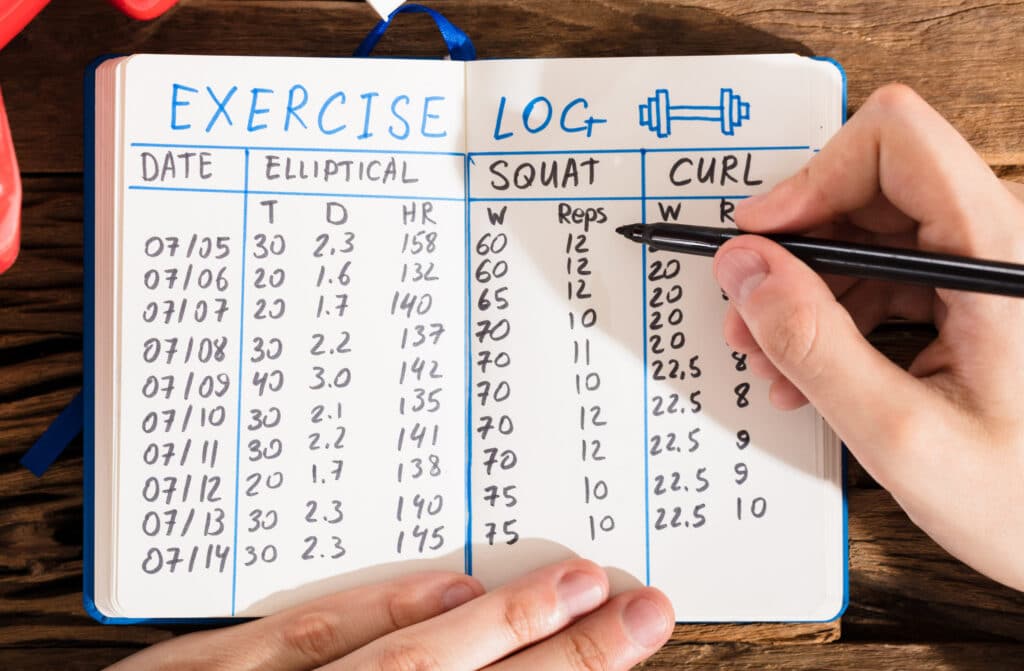In the fitness world, certain acronyms and terminology get tossed around frequently among seasoned gym-goers. One abbreviation that often arises is “PR,” but its meaning may not be obvious to newcomers. Today we will find out what the letters “PR” signify when used in weight training, powerlifting competitions, and general workout routines.
We’ll look into the precise definition of this gym lingo and why achieving a new personal “PR” is a coveted milestone for strength athletes and exercise enthusiasts alike.

Contents
What Does PR Mean In Gym?
In the gym, PR stands for Personal Record. It refers to your best achievement in a specific exercise or workout. This can be measured in a few ways, depending on the exercise:
- Weightlifting: The heaviest weight you’ve lifted for a specific number of repetitions (reps) or sets. For instance, a PR in squats might be 225 lbs for 5 reps.
- Cardio: The fastest time you’ve completed a certain distance, like a PR for a 5k run.
- Bodyweight Exercises: The most repetitions you’ve achieved with proper form in an exercise like push-ups or pull-ups.
PRs are a great way to track your progress in the gym and set personal goals. They help you see how much stronger, faster, or more enduring you’ve become over time. Here are some reasons why PRs are important:

- Motivation: Achieving a PR can be a great motivator to keep pushing yourself and reach new levels of fitness.
- Progress Tracking: PRs provide a concrete way to measure your improvement over time. You can use them to see how your training is paying off.
- Goal Setting: PRs can be used as stepping stones towards larger fitness goals. Once you achieve a PR, you can set a new, more challenging goal.
PRs are personal. Don’t compare yourself to others; focus on your progress and celebrate your achievements!
What Are Different PR Types?
Here are the different PR types:
1. Repetition PR (Rep PR): This PR is about achieving your highest number of reps for a specific exercise. It’s a good way to measure your progress and endurance over time.
2. Time-Based PR: This type of PR focuses on completing a workout or a specific exercise in the shortest time possible. It’s an excellent indicator of your speed, agility, and overall fitness improvement.
3. Weight PR: Weight PR involves lifting your heaviest weight for a particular exercise. It’s an essential marker of your strength gains and progression in your training.
4. Distance PR: In certain activities like running, hitting a Distance PR means achieving your best performance in terms of distance covered. This type of PR is common in endurance sports and reflects improvements in your endurance and stamina levels.
5. Routine-Based PR: This PR revolves around completing a specific routine or workout plan. It showcases your consistency, dedication, and ability to follow a structured fitness regimen.
How Do I Keep Track Of My PR In The Gym?
You’re keen on progressing and hitting new personal records (PRs) in the gym. Here’s how you can effectively keep track of your achievements:

- Maintain a Training Log: Recording your workouts, weights, and repetitions in a training log is essential. It helps you track your progress, identify patterns, and plan future goals.
- Use Fitness Apps: Make use of technology by utilizing fitness apps that allow you to input and track your PRs easily. These apps often provide additional features like progress graphs and workout history.
- Regularly Assess Your PRs: Set specific intervals, such as weekly or monthly, to reassess your PRs. Regularly reviewing and updating your records will ensure that you have up-to-date data on your achievements.
- Celebrate Milestones: Acknowledge and celebrate each new PR you achieve. Recognizing your accomplishments boosts morale and keeps you motivated to strive for further improvements.
- Consult with a Trainer: If you’re unsure about tracking your PRs effectively, consider seeking guidance from a fitness trainer. They can provide expert advice on how to monitor and enhance your performance in the gym.
How To Test Your PR?
To effectively test your Personal Record (PR) in the gym, follow these essential steps:

- Proper Warm-up: Ensure you’re physically and mentally ready by performing a suitable warm-up routine tailored to the type of PR you’re aiming for.
- Gradually Increase Intensity: When attempting a PR based on low reps or a single rep, gradually work your way up to the target weight to prepare your central nervous system and body adequately.
- Have a Spotter: It’s crucial to have a knowledgeable spotter or training partner present to offer support, motivation, and assistance to ensure safe and successful PR attempts.
- Use Safety Measures: Consider using safety hooks or catches in specific exercises as a failsafe in case you struggle to lift the weight during your PR attempt.
- Choose a Measurable Metric: Select a metric for your PR that is consistent, measurable, and aligned with your fitness goals.
Why Is Hitting New PR Necessary?

In the gym, hitting a new Personal Record (PR) is crucial for your progress and motivation. Here’s why it’s necessary:
- Motivation: Setting and achieving new PRs keeps you motivated to push yourself further and reach new heights in your fitness journey. It gives you a sense of accomplishment and drives you to keep improving.
- Progress: Hitting new PRs is a clear indicator of progress in your training. It helps you track your development and ensures that you are moving in the right direction towards your fitness goals. Working towards PRs helps you assess your current abilities and set challenging yet achievable targets.
- Accountability: Striving for new PRs holds you accountable for your training efforts. It encourages consistency in your workouts and pushes you to overcome challenges. Regularly setting and reaching new PRs keeps you on track and dedicated to your fitness routine.
How To Set Up New PR?
Setting up new Personal Records (PRs) in the gym is an exciting journey that requires focus, dedication, and smart strategies. Here are some practical tips to help you achieve your fitness milestones:
- Track Your Progress: Keep a detailed workout journal to record your sets, reps, weights, and any PRs you achieve. Tracking your progress is essential to identify areas for improvement and celebrate your successes.
- Set Specific Goals: Define clear, achievable goals for each workout session. Whether it’s increasing your weight by 5 pounds or adding an extra set, setting specific objectives will keep you motivated and focused.
- Gradual Progression: Avoid jumping to significantly heavier weights too quickly. Gradual progression is key to safely setting new PRs and reducing the risk of injury. Listen to your body and make incremental increases over time.
- Stay Consistent: Consistency is crucial in reaching new PRs. Stick to your workout schedule, stay committed to your training plan, and make adjustments as needed to keep progressing towards your goals.
- Rest and Recovery: Give your body ample time to rest and recover between workouts. Adequate sleep, proper nutrition, and active recovery techniques are essential for muscle growth and overall performance.
- Seek Professional Guidance: Consider working with a certified fitness trainer to help you develop a personalized training program tailored to your goals and abilities. Professional guidance can not only optimize your workouts but also ensure you’re setting safe and effective PRs.
Frequently Asked Questions
What are Personal Records (PRs) in the gym?
Personal Records (PRs) are achievements that mark significant milestones for an individual’s performance in various fitness aspects such as strength, speed, endurance, consistency, etc. PRs serve as benchmarks for progress and motivation to push beyond limits.
How many types of PRs are there?
There are different types of PRs including Repetition PR, Time-Based PR, Weight PR, Distance PR, and Routine-Based PR. Each type focuses on specific areas of fitness progress and provides goals for continuous improvement in one’s fitness journey.
Why are PRs important?
PRs are important as they help track improvements, set goals, and motivate to surpass personal limits. Achieving PRs signifies progress and growth in fitness, serving as a tangible way to measure success and celebrate achievements in the gym.
How can I set PR goals?
Setting PR goals involves defining specific targets for different types of PRs based on your fitness objectives. Start by identifying areas you want to improve in, such as strength, endurance, speed, and consistency, and then establish realistic and challenging goals to strive towards in your workouts.

Hello, I’m Ravindra. Over the years, I’ve immersed myself deeply into the world of fitness and health, transforming both my body and mind. Writing has allowed me to share my journey, insights, and expertise with those just starting out and seasoned fitness enthusiasts alike. Beyond just routines and diets, I believe in inspiring others to adopt a holistic approach to well-being.
